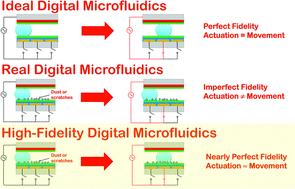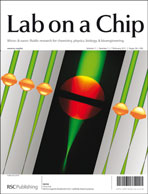A feedback control system for high-fidelity digital microfluidics†
Abstract
Digital microfluidics (DMF) is a technique in which discrete droplets are manipulated by applying electrical fields to an array of electrodes. In an ideal DMF system, each application of driving potential would cause a targeted droplet to move onto an energized electrode (i.e., perfect fidelity between driving voltage and actuation); however, in real systems, droplets are sometimes observed to resist movement onto particular electrodes. Here, we implement a sensing and feedback control system in which all droplet movements are monitored, such that when a movement failure is observed, additional driving voltages can be applied until the droplet completes the desired operation. The new system was evaluated for a series of liquids including


 Please wait while we load your content...
Please wait while we load your content...